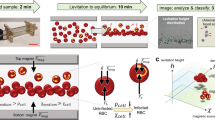Abstract
A simple and sensitive approach for detection of malarial parasite in blood samples is demonstrated. The approach exploits our finding that, in hypertonic buffer, a normal red blood cell (RBC) rotates by itself when trapped by an optical tweezers. The rotational speed increases linearly at lower trap-beam powers and more rapidly at higher powers. In contrast, under the same experimental conditions, RBC having a malarial parasite does not rotate. The rotational speeds of other RBCs from malaria-infected sample are of an order of magnitude less than that for normal RBC and also increase much more slowly with an increase in trap beam power than that for normal RBC. The difference in rotational speeds could be exploited for the diagnosis of malaria.
Similar content being viewed by others
References
Ashkin A, Dziedzic JM, Bjorkholm JE, Chu S (1986) Observation of a single-beam gradient force optical trap for dielectric particles. Opt. Lett. 11: 288–290.
Dasgupta R, Mohanty SK, Gupta PK (2003) Controlled rotation of biological microscopic objects using optical line tweezers. Biotechnol. Lett. 25: 1625–1628.
Evans E, Fung YC (1972) Improved measurements of the erythrocyte geometry. Microvasc. Res. 4: 335–347.
Galajda P, Ormos P (2001) Complex micromachines produced and driven by light. Appl. Phys. Lett. 78: 249–251.
Glenister FK, Coppel RL, Cowman AF, Mohandas N, Cooke BM (2002) Contribution of parasite proteins to altered mechanical properties of malaria-infected red blood cells. Blood 99: 1060–1063.
Hemvani N, Chitnis DS, Dixit DS, Asolkar MV (1999) Acridine orange stained blood wet mounts for fluorescent detection of malaria. Indian J. Pathol. Microbiol. 42: 125–128.
Keiser J, Utzinger J, Premji Z, Yamagata Y, Singer BH (2002) Acridine Orange for malaria diagnosis: its diagnostic performance, its promotion and implementation in Tanzania, and the implications for malaria control. Ann. Trop. Med. Parasitol. 96: 643–654.
Mela M, Eskelinen S (1984) Normal and homogeneous red blood cell populations over a wide range of hyper-iso-hypotonic media. III. Corrected volumes in Coulter Counter measurements. Acta Physiol Scand. 122: 515–525.
Mohanty SK, Parlikad M, Uppal A, Gupta PK (2002) Stretching of RBC using single point tweezers. In: Photonics 2002, 6th International Conference on Optoelectronics, Fiber Optics and Photonics, December 16-18, TIFR, Mumbai, India, pp. 15.
Weiss U (2002) Nature insight: malaria. Nature 415: 669–715.
Author information
Authors and Affiliations
Rights and permissions
About this article
Cite this article
Mohanty, S.K., Uppal, A. & Gupta, P.K. Self-rotation of red blood cells in optical tweezers: prospects for high throughput malaria diagnosis. Biotechnology Letters 26, 971–974 (2004). https://doi.org/10.1023/B:BILE.0000030041.94322.71
Issue Date:
DOI: https://doi.org/10.1023/B:BILE.0000030041.94322.71




